
OR WAIT null SECS
People Aged > 30 Years Report Inadequate Knowledge Towards Gouty Arthritis
Although half of participants strongly agreed that gouty arthritis is painful and can cause anxiety, only 15.28% agreed on the importance of dietary intake as a means for prevention.
The general population of people aged > 30 years reported inadequate knowledge, less proactive practices, and unfavorable attitudes towards gouty arthritis, according to a web-based, cross-sectional study published in BMC Medical Education.1
“Given that gouty arthritis is a public health issue in some populations with a high incidence and prevalence and since gouty arthritis is associated with modifiable risk factors (eg, alcohol consumption and fructose and high purine foods), a knowledge of gouty arthritis could help in the primary prevention of gouty arthritis development and lead to an early diagnosis if it occurs,” wrote a group of Chinese investigators. “The knowledge, attitudes, and practices (KAP) methodology is a structural survey method that allows the identification of gaps that constitute barriers to the appropriate implementation or performance of a specific subject in a specific population.”
Although previous research has noted gaps in knowledge among primary clinicians and patients, no KAP data on gout or gouty arthritis are available in China.2
To assess the KAP of gouty arthritis in the Chinese population, investigators created a questionnaire based on available guidelines. Eligible participants were aged > 30 years residing in Chengdu, Sichuan and were enrolled between January and March 2023. In addition to questions regarding the knowledge, attitude, and practice dimensions, the questionnaire included demographic characteristics—such as age, gender, work status, income, residence, and education.
Higher scores were representative of better knowledge, a positive attitude, and proactive practice, with a score of 70% considered “good.” Factors influencing KAP were identified using multivariable and structural equation modeling (SEM) analyses.
In total, 537 questionnaires were included, with a median knowledge score of 13.12 ± 6.41, an attitude score of 25.38 ± 3.97, and a practice score of 45.25 ± 5.77. Factors independently associated with knowledge were female sex (odds ratio [OR] = 0.47, 95% confidence interval [CI]: 0.31 – 0.71, P <.001), suburban living (OR = 0.18, 95% CI: 0.04 – 0.78, P = .022), an income of < 2,000 yuan (OR = 0.35, 95% CI: 0.14 – 0.85, P = .021), and being the head of an institution or organization and professional and technical staff (OR = 2.04, 95% CI: 1.23–3.39, P = .006).
Factors associated with attitudes included female sex (OR = 2.17, 95% CI: 1.43 – 3.30, P <.001), age (OR = 1.03, 95% CI: 1.01 – 1.05, P = .001), an income of 5,000 – 10,000 yuan (OR = 2.05, 95% CI: 1.27 – 3.31, P = .003), an income of > 10,000 yuan (OR = 2.07, 95% CI: 1.12 – 3.81, P = .020), and achieving a college education or above (OR = 2.26, 95% CI: 1.16 – 4.41, P = .017).
Similarly, female sex (OR = 1.62, 95% CI: 1.01 – 2.58, P = .044), age (OR = 1.02, 95% CI: 1.00 - 1.04, P = .016), and attitude (OR = 1.31, 95% CI: 1.23–1.40, P < 0.001) were independently associated with practices.
Although half (50.23%) of participants strongly agreed that gouty arthritis is painful and can cause anxiety, only 15.28% agreed on the importance of dietary intake as a means for prevention. Common symptoms of gouty arthritis, such as swelling, joint pain, redness, and heat, were recognized by 55.31% of subjects and 51.21% knew lifestyle factors could contribute to gout, but only 39.66% knew that gout pain can resolve on its own within a timeframe of a few days to 2 weeks.
According to the questionnaires, knowledge directly influenced attitudes towards gouty arthritis (β = -.10, P <.001) and indirectly influenced practice (β = -.07, P <.001). Additionally, knowledge indirectly influenced practice (β = -.07, P <.001), while attitude directly influenced practice (β = 0.68, P <.001).
Investigators mentioned the relatively small sample size, the cross-sectional design, and recruiting patients from a single area as limitations of the study. Additionally, KAP surveys are at an inherent risk of social desirability bias. Despite these limitations, results could be used as a baseline to evaluate the effect of future interventions.
“Targeted interventions should prioritize improving knowledge about gout and fostering positive attitudes toward its management,” investigators concluded.
References
- Zhao, M., Jian, J., Yang, D. et al. Knowledge, attitudes, and practices of gouty arthritis in the general population aged > 30. BMC Med Educ 24, 775 (2024). https://doi.org/10.1186/s12909-024-05690-x
- Spaetgens B, Pustjens T, Scheepers L, Janssens H, van der Linden S, Boonen A. Knowledge, illness perceptions and stated clinical practice behaviour in management of gout: a mixed methods study in general practice. Clin Rheumatol. 2016;35(8):2053–61.


